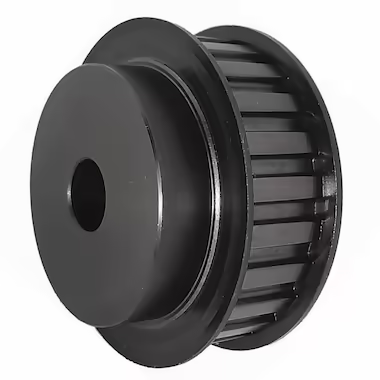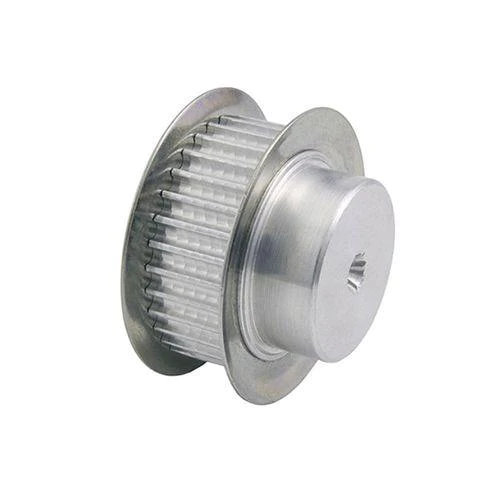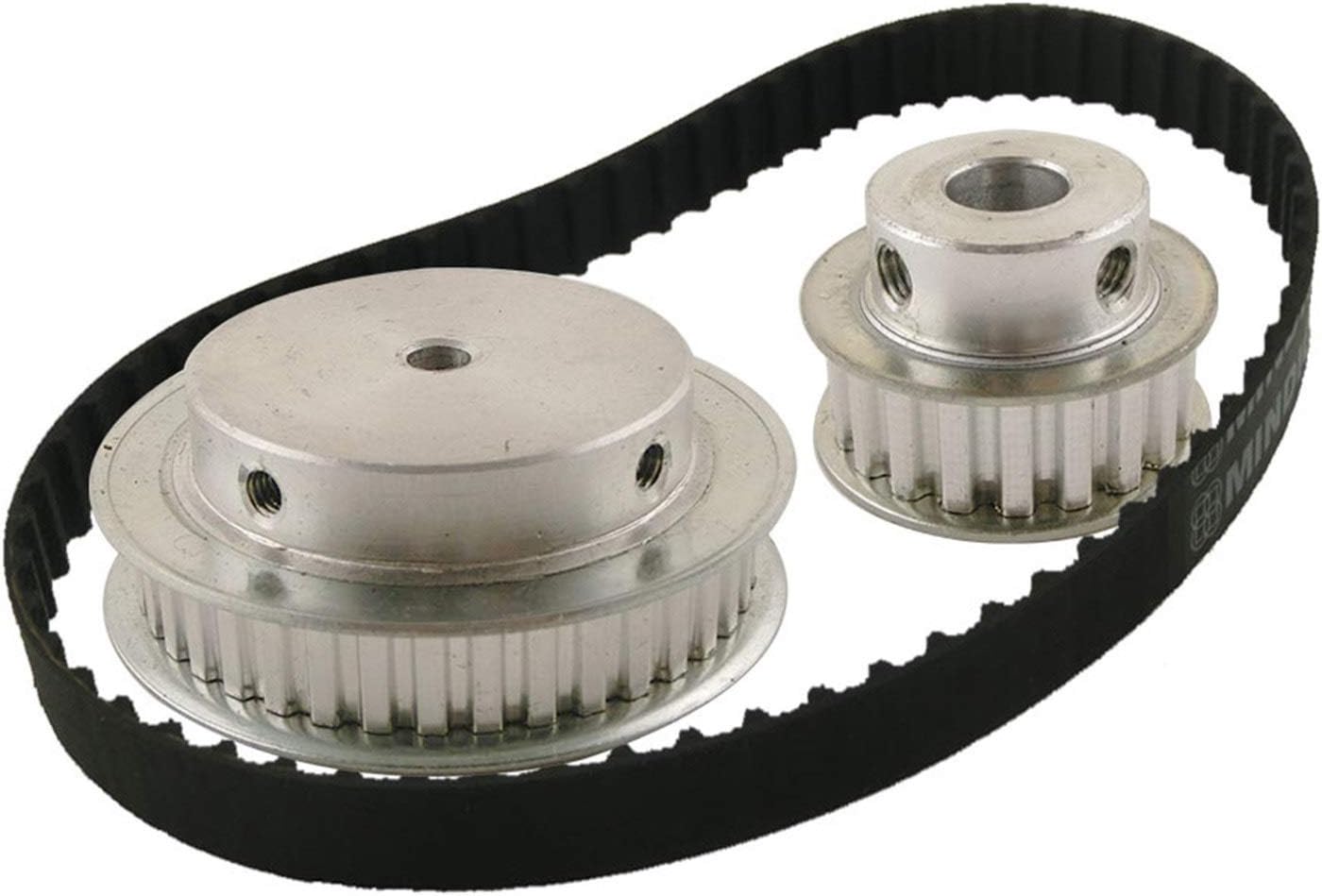Product Description
| Product Name | Timing Belt Pulley |
| Teeth Quantity | 10-150 teeth or customized |
| Teeth profile | HTD MXL XL L H XH XXH T2.5 T5 T10 AT5 AT10 S2M S3M S5M S8M GT2 GT3 GT5 3M 5M 8M |
| Accessories | We can provide the service of assembling setscrews, bearings, shafts or taper bush |
| Surface treatment | Anodize,Black Oxide,Phosphate and Galvanization |
| Place of origin | China |
Main Products:
Timing belt pulleys, timing bars, timing belt clamping plates.
Locking elements and shrink discs: could be alternative for Ringfeder, Sati, Chiaravalli, BEA, KBK, Tollok, etc.
V belt pulleys and taper lock bush.
Sprockets, idler, and plate wheels.
Gears and racks: spur gear, helical gear, bevel gear, worm gear, gear rack.
Shaft couplings: miniature coupling, curved tooth coupling, chain coupling, HRC coupling, NM coupling, FCL coupling, GE coupling, rigid and flexible coupling, jaw coupling, disc coupling, multi-beam coupling, universal joint, torque limiter, shaft collars.
Forging, Casting, Stamping Parts.
Other customized power transmission products and Machining Parts (OEM).
Advantage:
1. Factory directly supply , we can continue to provide a stable supply
2. Many years manufacture experience , top quality guaranteed by skilled workers, managing system and status of facilities.
3. Competitive and reasonable price
4. OEM service, we can do as your drawings or samples
5. Quality Guarantee, 100% inspect before delivery
6. Good after-sale service, Our wokers are all professional and all can speak English.
7. Timely delivery, We have many long cooperation supplier. supply ONE-STOP service
8. High-tech CNC Machines
9. Independent Engineering Department
10.Kinds of surface treatment—Zinc Plating, Powder Coating, Anodizing, Chrome Plate, RoHs .etc .
| Certification: | ISO |
|---|---|
| Pulley Sizes: | Mxl XL L H Xh Xxh T2.5 T5 T10 At5 At10 3m 5m 8m |
| Manufacturing Process: | Forging |
| Material: | Alloy |
| Surface Treatment: | Oxygenation |
| Application: | Chemical Industry, Grain Transport, Mining Transport, Power Plant |
| Samples: |
US$ 0.1/Piece
1 Piece(Min.Order) | |
|---|
| Customization: |
Available
| Customized Request |
|---|

How do XL pulleys compare to other pulley types, such as HTD or V-belt pulleys?
XL pulleys, HTD pulleys, and V-belt pulleys are all popular types of pulleys used in mechanical systems. Here is a detailed comparison of XL pulleys with HTD and V-belt pulleys:
1. Tooth Profile:
XL pulleys and HTD (High Torque Drive) pulleys both utilize toothed belts for power transmission. The main difference lies in their tooth profiles. XL pulleys have trapezoidal teeth, while HTD pulleys have a curvilinear tooth profile. V-belt pulleys, on the other hand, are designed for V-belts, which have a wider, wedge-shaped cross-section.
2. Power Transmission Capacity:
XL pulleys and HTD pulleys offer higher power transmission capacities compared to V-belt pulleys. The toothed belt designs of XL and HTD pulleys provide a positive engagement, preventing slippage under higher loads or torque. V-belt pulleys rely on friction between the belt and pulley, limiting their power transmission capacity.
3. Speed Capability:
XL pulleys and HTD pulleys are both suitable for higher speed applications compared to V-belt pulleys. The toothed belt designs allow for better grip and reduced belt slippage, enabling XL and HTD pulleys to operate at higher rotational speeds without compromising performance. V-belt pulleys are generally suitable for lower speed applications.
4. Efficiency:
XL pulleys and HTD pulleys offer higher efficiency compared to V-belt pulleys. The positive engagement between the toothed belts and pulleys in XL and HTD systems minimizes slippage and associated energy losses. V-belt pulleys, relying on friction, may experience higher energy losses due to belt slip.
5. Precision and Positioning:
XL pulleys and HTD pulleys provide better positional accuracy and reduced backlash compared to V-belt pulleys. The toothed belt systems offer improved control and synchronization, making them suitable for applications that require precise positioning or timing, such as robotics or CNC machines.
6. Noise and Vibration:
XL pulleys and HTD pulleys generally produce less noise and vibration compared to V-belt pulleys. The toothed belt systems exhibit smoother operation due to their positive engagement, reducing noise and vibration levels. V-belt pulleys may generate more noise and vibration due to potential slippage and belt oscillation.
7. Installation and Maintenance:
XL pulleys, HTD pulleys, and V-belt pulleys are all relatively easy to install and maintain. However, V-belt pulleys may require more frequent tension adjustments and periodic belt replacements due to belt wear and stretch. Toothed belt systems, including XL and HTD pulleys, often require less maintenance and offer longer belt life.
8. Application Suitability:
The choice between XL pulleys, HTD pulleys, and V-belt pulleys depends on the specific application requirements. XL and HTD pulleys are commonly used in industrial automation, power transmission, and precision machinery applications that demand higher torque, speed, and accuracy. V-belt pulleys are often employed in applications such as HVAC systems, automotive engines, and smaller machinery.
In summary, XL pulleys, HTD pulleys, and V-belt pulleys have differences in tooth profile, power transmission capacity, speed capability, efficiency, precision, noise/vibration levels, installation/maintenance, and application suitability. Understanding these differences is crucial in selecting the most appropriate pulley type for a given mechanical system and its specific requirements.

How does the size of an XL pulley impact its load-bearing capacity?
The size of an XL pulley plays a significant role in determining its load-bearing capacity. Here’s how the size of an XL pulley impacts its load-bearing capacity:
1. Surface Area:
The size of the pulley affects the surface area over which the force is distributed. Larger pulleys generally have a larger surface area, allowing for better force distribution and reducing the stress concentration on the pulley. This increased surface area helps in handling higher loads and reduces the risk of pulley failure.
2. Moment Arm:
The size of the pulley also affects the moment arm, which is the perpendicular distance from the center of the pulley to the line of action of the force. A larger pulley typically has a longer moment arm, resulting in a larger torque or moment applied to the pulley. This increased torque capacity allows the pulley to handle higher loads without experiencing excessive deflection or failure.
3. Tooth Engagement:
XL pulleys transmit power through the engagement of their teeth with the corresponding teeth on the timing belt. The size of the pulley determines the number of teeth and the contact area between the pulley and the belt. A larger pulley with more teeth provides increased contact area and better tooth engagement, resulting in improved load-bearing capacity and power transmission efficiency.
4. Material Strength:
The size of the pulley can also impact the selection of materials with appropriate strength properties. Larger pulleys may require materials with higher strength to withstand the increased loads. The choice of materials with adequate tensile strength, fatigue resistance, and durability becomes crucial in ensuring the load-bearing capacity of the pulley.
5. Speed and Torque:
The size of the pulley influences the speed and torque characteristics of the system. Larger pulleys can accommodate larger belts, resulting in increased belt contact surface and improved power transmission. This allows for higher torque transfer capabilities, enabling the pulley to handle heavier loads.
It’s important to note that while larger pulleys generally have higher load-bearing capacities, other factors such as material properties, design considerations, and proper installation also influence the overall load capacity of the pulley system. Therefore, it is essential to consult the manufacturer’s guidelines and engineering calculations to determine the appropriate pulley size and ensure safe operation under the desired load conditions.

Can you explain the key characteristics and specifications of XL pulleys?
XL pulleys have specific characteristics and specifications that are important to understand for their proper selection and use. Here are the key details:
1. Tooth Profile:
XL pulleys have a tooth profile designed to work with XL timing belts. The tooth profile is trapezoidal in shape, with specific dimensions and angles to ensure precise engagement with the corresponding teeth on the timing belt.
2. Pitch Size:
The pitch size of an XL pulley refers to the distance between adjacent tooth centers. XL pulleys have a standardized pitch size of 0.200 inches (5.08 mm). This pitch size ensures compatibility with XL timing belts of the same pitch, allowing for easy interchangeability.
3. Belt Width Compatibility:
XL pulleys are designed to accommodate XL timing belts of specific widths. The belt width is determined by the application requirements and load considerations. XL pulleys are available in various groove widths to match the corresponding XL timing belt width, ensuring proper belt engagement and power transmission.
4. Material and Construction:
XL pulleys are commonly made from materials such as aluminum, steel, or plastic. The choice of material depends on factors like the application requirements, load capacity, and cost considerations. The pulleys are precision-machined to ensure accurate tooth profiles, smooth operation, and reliable performance.
5. Number of Teeth:
The number of teeth on an XL pulley determines the speed ratio and the positioning accuracy of the motion control system. The number of teeth can vary depending on the specific application requirements and the desired speed and torque ratios.
6. Flange Options:
XL pulleys may come with flanges on one or both sides. Flanges provide additional support to the timing belt, preventing it from slipping off the pulley during operation. The presence and configuration of flanges depend on the specific application needs and the desired level of belt stability.
7. Application Range:
XL pulleys are suitable for applications that require precise motion control, such as robotics, CNC machines, 3D printers, and other automated systems. They can handle moderate to high torque requirements and operate at various speeds, depending on the specific pulley size, material, and construction.
8. Interchangeability:
Due to standardized pitch sizes and tooth profiles, XL pulleys from different manufacturers are interchangeable with XL timing belts of the same specifications. This interchangeability simplifies replacement, maintenance, and system upgrades.
Understanding these key characteristics and specifications of XL pulleys is essential for selecting the right pulley for a given application, ensuring proper power transmission, and achieving accurate motion control.


editor by CX
2023-11-27












.jpg)

